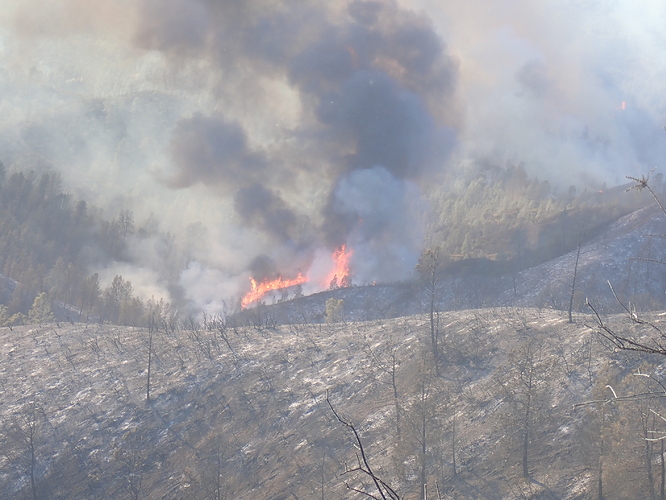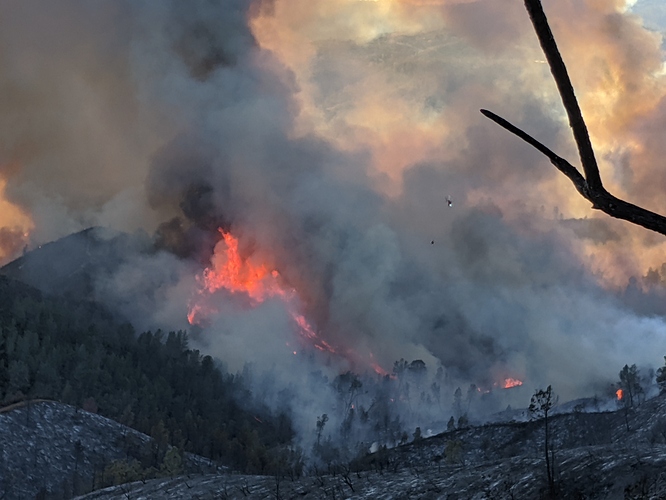In Arizona, a lot.
A team yet?
Oregon Strike Team 11 is on the fire, I think a bulk from Clackamas County?
And Washington has some Type 6 here. https://twitter.com/i/web/status/1191506312317661184
Any word on latest resource orders?
Looks as though the firing show has begun…
North winds coming
Light east wind right now.
https://www.wrh.noaa.gov/mesowest/timeseries.php?sid=PG336&num=168&banner=gmap&raw=0&w=325
I believe FRA is just to the west of the fire…
Yep. West of Div E & H.
The Ac are going up however percent contained is not going down
This is exactly what is about to happen later today, nearly word for word. Lots of prepping and planning still, but if it goes through, this is about to become a very successful VMP.
Although just over 2500 acres, the Ranch Fire had 1200 personnel, 100 engines, 40 hand crews and loads of other equipment assigned. I just want to give credit to TGU for not requesting a Type 1 team on this as the logistics alone called for one. Great stop and great job by all!
Today’s NIFC Situation Report puts the fire’s cost at $10 million. That’s $4,000/acre. The market price for good grazing land in Tehama County right now is around $1,000/acre, and for chamise shrublands (which comprised most of this fire) closer to $400/acre.
I mean no disrespect to the firefighters that just busted their asses to put this fire out, but how can we justify keeping on spending so much money (and risking firefighters lives) to keep fire off of land that needs to burn?
(Full disclosure: I’ve made a living as a wildfire suppression contractor for the past 20 years)…
Again, if you only see things from one viewpoint- then your opinion is skewed… If the only measure of the suppression mode is the market value of the land- then when land prices are down we should just let everything burn? Is there not more value to the land than just what the real estate market gives it? Is there not a threat to public safety? Is there not a component of water quality? Is there not a component of the person who owns the land and their wishes for it? Is there value derived from the property and the property taxes it generates? Is there value in a hunting club?
The idea of tuning it into a big VMP sounds great, but that would imply there were many things in place before that could occur- including a prescription to achieve desired results…
True True, I look at it as also a good opportunity for the number of New FF’s , FAE’s, FCB, FC, BC, Hot Shot Crews, Type II Crews, that we’re using direct and indirect tactics to obtain the Objective. With this being a slower summer, this might have been the only slide in their slide show for this fire season, that can be built for future fire seasons.
The local TGU BC’s did great on this. I’m sure a number of factors kept it local instead of team order, including the slower rate of spread, no fire wx in forecast, very few to evacuate, lots of agency aircraft available due to no other incidents, during IA some out-of-state Type 3 and 6 task forces were passing through from Kincade. And there’s room and time out there to rethink strategies should conditions change. Basically not much complexity, yet. Trainees and others got to cut their teeth on not just the standard 100acre foothill fire, but a fire that had it all, but still had a leash on it.
The “VMP” piece for it would have been interesting, and would have drastically lowered the cost per acre, for those that follow that. The negotiation between ops and ATGS that morning discussing that plan was interesting. Lots was being said without being said. Ops thought the line was still hot enough and terrain rough enough to not go direct, but once the players were flown a recon over that line, the “VMP” firing op was set aside for direct line. Also the firing op would have brought the fire to the edge of “room to rethink strategies”, right up to MNF boundary and timber (with dozer line already in a few sections of MNF for this).
The bulk of that cost was aircraft, which are crucial in this area of TGU due to sheer remoteness and travel time for ground units. You can’t avoid that cost. Aircraft kept the leash on this thing (and the weather…) so ground resources could wrap it. Strong work everyone!
I was on this fire as well. I would not second guess any tactical decision or ordering decision made during this incident. As has been said, this is some very rugged, steep, unforgiving terrain. The only reason this fire was kept to 2500 acres is due to the fact large amounts of retardant and water was placed on the west flank by aircraft on Tuesday and it was successful in nearly extinguishing the west flank. That was not evident until mid-day on Wednesday. By getting the results they did from the aircraft, it allowed crews to go direct. Had there been any significant heat in the left flank, I would totally agree to the bigger box concept. It would have been way to dangerous to get those crews in there. We all listened to the dozer operators repeatedly attempt to put in lines only to get rocked out or encounter areas way too steep to complete lines. We all know too well how fire can chew through those retardant lines. If the fire had continued to the west or firing operations initiated, the resources already there would have been stretched thin. Just my humble opinion.


